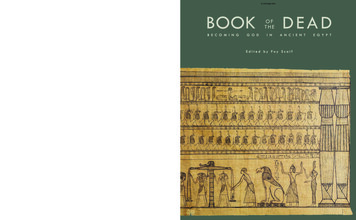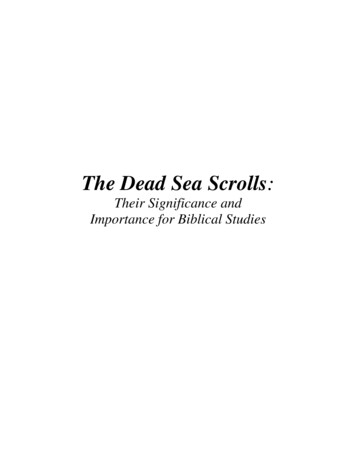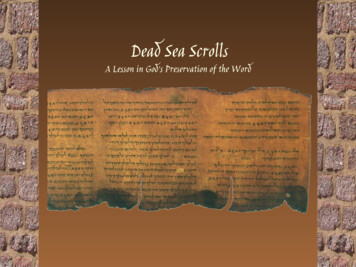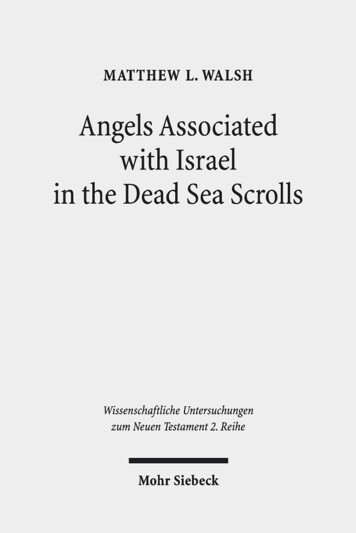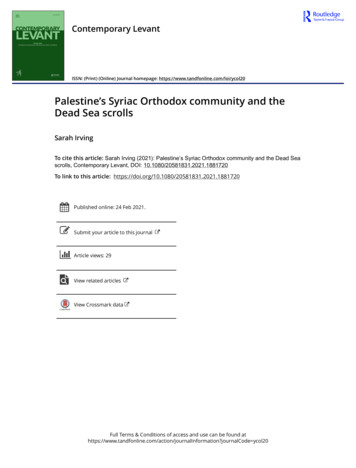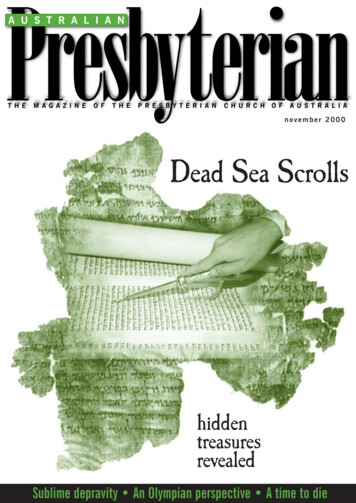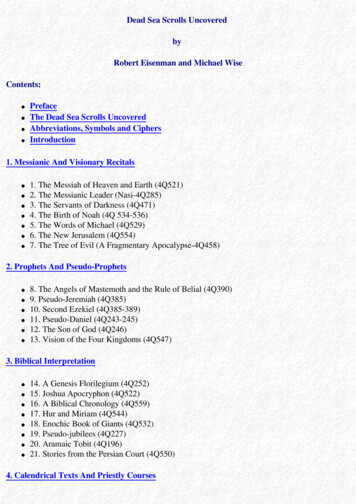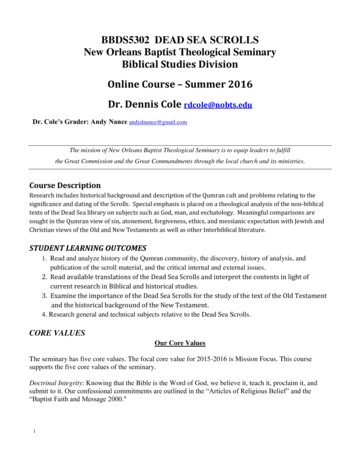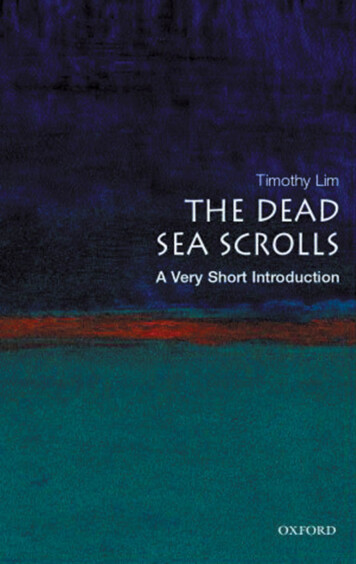
Transcription
Timothy H. LimTHE DEAD SEASCROLLSA Very Short Introduction1
ContentsList of illustrations ix1234567891011The Dead Sea scrolls as cultural icon 1The archaeological site and caves20On scrolls and fragments 32New light on the Hebrew BibleWho owned the scrolls?4058Literary compositions from the Qumran library 66The Qumran-Essene community in context 72The Qumran community84The religious beliefs of the Qumran communityThe scrolls and early Christianity106The greatest manuscript discovery 117References121Further reading 127Appendix: Hitherto unknown textsIndex135130100
List of illustrations1Headline from the Times,6 June 199627 The Habakkuk Pesher 33 The Israel Museum, JerusalemNI Syndication2 Judaean Desert8 Timothy H. Lim3 The Shrine of the Book,Israel Museum108 The Rule of theCommunity9 The Leningrad Codex 44Department of Manuscripts,National Library of Russia Buddy Mays/Corbis4 Front cover, On Scrolls,Artefacts and IntellectualProperty19Timothy H. Lim, Hector L.MacQueen, and Calum M.Carmichael (eds.) (Sheffield:Sheffield Academic Press, 2001)10Copy of Samuel,preserving 1 Samuel10–1148Israel Antiquities Authority115 Aerial view of KhirbetQumran24Albatross6 Maps of the Dead Seaarea, showing location ofKhirbet Qumran, thecaves, and cemetery2834 The Israel Museum, JerusalemFragment of4QGen-Exoda namingMount Moriah as‘Elohim Yireh’50Israel Antiquities Authority12David and Goliath inbattle53The Metropolitan Museum ofArt, gift of J. Pierpont Morgan,1917
13Reconstruction of the‘scriptorium’ and ‘library’of the Qumrancommunity67Leen Ritmeyer14Sectarian documentIsrael Antiquities Authority8315Fragment with Greekletters from Cave 7108Israel Antiquities Authority16The ‘slain messiah’fragment fromCave 4110Israel Antiquities AuthorityThe publisher and the author apologize for any errors or omissionsin the above list. If contacted they will be pleased to rectify these atthe earliest opportunity.
Chapter 1The Dead Sea Scrolls ascultural iconMany people have heard of the Dead Sea Scrolls, but few knowwhat they are or the significance they have for our understandingof the Old Testament or Hebrew Bible, ancient Judaism, and theorigins of Christianity. Since their discovery in 1947, andespecially from 1991 when all the remaining, unedited scrollswere released to the world at large, there has been a surge ofpublications, ranging from the popular to the technical. Thetechnical works are inaccessible to most people apart fromspecialists, and the popular books vary in quality, from thesensational blockbusters (often involving a Vatican conspiracytheory) to the sound and reliable.In this Very Short Introduction to the Dead Sea Scrolls, I willdiscuss the discovery, the controversies and personalities involvedin the scholarly debates, the legal actions, the politics, and thevested religious interests. Moreover, I will introduce traditionaland specialist studies of Jewish history and thought between200 BCE and 70 CE, the archaeology of the Khirbet Qumran(the area where the scrolls were discovered), palaeography(‘study of old handwriting’), textual criticism, philology, linguistics,and ancient biblical exegeses. There will also be a discussion ofthe most recent scientific techniques, often neglected byintroductory textbooks. In keeping with the aims of this series,the treatment of each topic will necessarily be brief and selective;1
The Dead Sea Scrollsthe intention is to whet your appetite and to pique your interestrather than to provide a comprehensive introduction to the DeadSea Scrolls.A newspaper headline in The Independent on 12 November 2004read ‘Afghanistan wants its ‘‘Dead Sea Scrolls of Buddhism’’ backfrom UK’. The article, written by Nick Meo, reported that DrSahyeed Rahneen, the Minister for Culture and Information ofAfghanistan, was attempting to restore the collection of the KabulMuseum and would be formally requesting the return of theKharosti scrolls from the British government. The Kabul Museumhad been ransacked during the war that ousted the Talibangovernment and the collection of sixty fragments of scrolls, writtenon birch bark and in the ancient script of Kharosti, disappeared intothe antiquities market before resurfacing at the British Library in1994 (Figure 1).Notable is the way the newspaper headline used ‘the Dead SeaScrolls’ to signify a collection of ancient manuscript finds. TheKharosti texts are Buddhist scrolls dating to the 1st century CE andhave no historical connection to Judaism. They are significant forthe study of the early development of Buddhism and the search forthe historical Buddha. The comparison, suggested by the staff of theBritish Library, was intended to underscore their great antiquityand importance. The peculiar usage of the name in a nationalnewspaper is evidence that the Dead Sea Scrolls have taken on asymbolic status. They are no longer just the scrolls of a Jewish sect1. A newspaper headline in The Times on 6 June 1996 using the ‘DeadSea Scrolls’ symbolically to represent ancient and importantdiscoveries2
that lived by the Dead Sea, but represent any important discovery ofancient manuscripts.In transcending, so to speak, the historical context of SecondTemple Judaism (515 BCE to 70 CE), the Dead Sea Scrolls havebecome a cultural icon. Popular fiction, such as the bestseller TheDa Vinci Code by Dan Brown, peppers its narrative with referencesto them in order to add intrigue and mystery to the story. Or again,in an earlier novel called The Mandelbaum Gate, published in 1965by Muriel Spark, the well-known author of The Prime of Miss JeanBrodie, the fiancé of the main character works as an archaeologistexcavating Khirbet Qumran. How did the scrolls become sopopular?The reasons for the popularity of the Dead Sea Scrolls are not far tofind. From their initial discovery by two Bedouin shepherds in 1947to the ‘battle for the scrolls’ in the late 1980s and early 1990s, themedia have always been involved in reporting the finds, the politics,the personalities, and the academic squabbles, to an interestedpublic. Some of the reporting trades on sensationalism, with orwithout the backing of one or more academics; other reports offersound coverage of the latest developments in scrolls research; andthere is, moreover, a whole range of other types of publicity betweenthese poles. In any case, the involvement of the media –newspapers, television, and radio – have ensured that the public,especially in the United Kingdom, United States, Canada, andAustralia, would have read or heard about the Dead Sea Scrolls.Early in my own academic career, I experienced first hand the rolethe media played in popularizing the scrolls. In 1991, I had justfinished my doctorate on the scrolls in Oxford and had become theKennicott Hebrew Fellow at the Oriental Institute. It was duringthat time that access was being sought to the remaining uneditedscrolls from Cave 4, in what has been described as ‘the battle for the3The Dead Sea Scrolls as cultural iconThe media and the scrolls
The Dead Sea Scrollsscrolls’. Essentially, the conflict was drawn between a small group ofscholars who had in their possession unpublished material from thelargest depository of the eleven caves of Qumran, Cave 4, and otherswho wanted and demanded access to them for research and study.The tension between the haves and have-nots had been building upfor several years, but it came to a head in the summer and autumnof 1991. On 29 October 1991, after much bad blood had been spilt,the battle was won by the advocates of free access when it wasannounced by the Israel Antiquities Authority that a new policy ofaccess was being implemented. An article reported in The Timesheralded the news with this headline: ‘Israel opens access to theDead Sea scrolls’.Within weeks of the announcement of the new policy, twoAmerican scholars, Michael Wise, then of the University of Chicago,and Robert Eisenman of California State University at Long Beach,announced to the world the discovery among the hithertounpublished scrolls of a small fragment that allegedly attests to aslain or pierced messiah. With Geza Vermes, one of the leadingscrolls scholars, I organized a seminar in Oxford that examined thesix-line text, concluding that quite to the contrary the fragmentdoes not speak of a messiah who is slain but rather an anointedPrince of the Congregation who puts his enemy to death. I willdiscuss the details of these diverging interpretations in a laterchapter on the relationship between the scrolls and earlyChristianity.The seminar was covered by a journalist, Oliver Gillie, and hisarticle appeared on the front and inside page of The Independentpublished on 27 December 1991. One of the features of the seminarthat was highlighted in the subsequent reporting was the useof computer technology and imaging software to enhance theHebrew script. The imaging equipment was available at Yarntonof the Oxford Centre for Hebrew and Jewish Studies as part of theQumran Project, funded by an anonymous donor under theguidance of Alan Crown, formerly of the University of Sydney. I had4
produced an enlarged and enhanced image of what turned out to befragment 5 (now renumbered as 7) of 4Q285 (4 Cave 4;Q Qumran; and 285 the number assigned to the scroll), whichwas subsequently published in the Journal of Jewish Studies. Thiswas one of the first applications of imaging software to the study ofthe scrolls, and the publication of the enhanced and blown-upfragment 5 astounded readers of the Journal.The reason is that it is the connection to Christianity that makes thescrolls sensational. If, for instance, ‘a slain messiah’ could be foundin one of the Dead Sea Scrolls, then some have argued that it wouldcall into question the uniqueness of Jesus and the foundations ofthe Christian faith. As an aside, this type of argument, baldly statedas it often is in the media, depends upon a rather simplisticunderstanding of Jesus and the Christian faith in supposing that thediscovery of an archaeological artefact would undermineChristianity in this way. Within Jewish history, Jesus was not theonly person to have been considered a messiah, even a sufferingone, by his followers. Regardless, it could be argued that ‘a slain5The Dead Sea Scrolls as cultural iconSeveral aspects of this episode are noteworthy. First, the date of thepublication of the newspaper article coincided with the Christmasseason. This was reasonable since the Oxford seminar wasconvened on 20 December. Over the years, however, I have noticedthat the pattern of media reports and broadcasts, in thebroadsheets, on the radio, or television, almost always followsChristmas or Easter. Of course, this should not be surprising, sincethe scrolls are religious documents and are of particular interestduring the annual cycle of festivals, but it is the Christian, and notJewish, holy days that are followed. The fact that the movablefeast of Easter is based upon the date of the Passover does notdetract from the point that the media have in their sights theChristian rather than Jewish religious cycle. Why not publishreports to correspond to the Jewish New Year or Yom Kippur (Dayof Atonement), for instance, since almost all scholars believe thatthe scrolls are Jewish and not Christian?
messiah’ figure in the scrolls would not question the uniqueness ofChrist, but would rather underscore the view increasingly acceptedby Christians in the post-Holocaust, interfaith dialogue that Jesuswas a Jew and not a Christian.The Dead Sea ScrollsSecond, the application of modern technology to the study ofancient manuscripts has its own inherent fascination, the contrastbetween the very old manuscripts and cutting edge electronic tools.With the explosion of computer applications and web technology inthe past decade and a half, there are now impressive sites, like theOrion Center for the Study of the Dead Sea Scrolls and AssociatedLiterature (http://orion.mscc.huji.ac.il/) of the Hebrew Universityof Jerusalem, mounted on the web that will allow a ‘surfer’ to takea virtual visit of Khirbet Qumran, join an ongoing discussion groupor search the bibliographical database.Computer technology is used in an increasing number ofapplications for scrolls research and the dissemination ofinformation. In 1997, I edited The Dead Sea Scrolls ElectronicReference Library, a CD ROM database that would allow scholars tosearch for images of specific scrolls, enhance and print them out forpersonal study. This was followed by volume 2, produced by theFoundation for Ancient Research and Mormon Studies, BrighamYoung University, with a database edited by Emanuel Tov, includinga searchable transcription and translation of all the non-biblicalscrolls.Other notable developments and projects in the United Statesinclude the enhancing and reduction of background ‘noise’ of a textcalled Genesis Apocryphon by Gregory H. Bearman, a scientist ofthe Jet Propulsion Laboratory in Pasadena, who specializes inanalysing satellite images. Bearman developed a technique calledmulti-spectral imaging to produce readings (for instance, ‘the bookof Noah’) invisible to the human eye from the badly deterioratedscript. Application of computer enhancing technology is likewisebeing deployed at Princeton in connection with the Princeton6
Theological Seminary Dead Sea Scrolls Project edited by James H.Charlesworth.Access to the Cave 4 scrolls and the reading of a putative ‘slainmessiah’ fragment are two of the recent controversies. There havebeen others in the eventful past half century or so. For instance,John Allegro, a British scholar at the University of Manchester, ledexpeditions to the Judaean Desert to hunt for the treasuresmentioned in the Copper Scroll (Figure 2).Tourism and the Dead Sea ScrollsAnother reason for the popularity of the Dead Sea Scrolls istourism. Every year thousands of tourists and pilgrims descend onIsrael, visiting places holy to Judaism, Christianity and Islam.Among them the archaeological site of Khirbet Qumran in theJudaean Desert and the Shrine of the Book of the Israel Museum,figure high on the list of places to visit. At Khirbet Qumran they areled by informed guides around the archaeological site and are givena viewing of the nearby caves. Even at a time of unrest, the numberof tourists is impressive. According to Israel’s Ministry of Tourismfigures, last year 46,000 visitors passed through the Qumran site.7The Dead Sea Scrolls as cultural iconThis scroll from Cave 3 is unique among the Dead Sea Scrolls inusing copper as its writing material. All the other scrolls werewritten on skin or papyrus. The text, etched on copper plates,describes sixty-four hiding places of gold, silver, Temple sacrificesand another copy of the same scroll in the Judaean Desert. Thesetreasures are what Allegro set out to find. Other scholars interpretthe treasures, amounting to some sixty-five tons of silver andtwenty-five tons of gold, as literary fiction and liken the copperscroll to the text massekhet kelim (tractate of the Temple vessels), amediaeval text that described how the treasures of the SolomonicTemple were sequestered to a tower in Baghdad and their hidingplaces recorded on a copper tablet. Allegro failed to turn up anytreasure, but his expeditions were widely reported in the media.
2. The Copper Scroll itemises sixty-four places in the Judaean Desert where treasures are hidden
Interested consumers can now purchase facsimiles of scrolls andthe jars in which some of the manuscripts were stored, as well as awhole range of paraphernalia, including ‘Dead Sea Scrolls’ pens,t-shirts, ties, scarves and mud.Politics and the Dead Sea ScrollsThe political capital made out of the Dead Sea Scrolls by Israel’sleading politicians was not lost on us, but a dignified silence wasmaintained. It was only when it was mentioned that the Dead SeaScrolls were vital for Jerusalem did a disapproving titter ripple9The Dead Sea Scrolls as cultural iconThe Dead Sea Scrolls are also regarded as a cultural icon in Israel.On 20–25 July 1997, scholars from around the world were invited toJerusalem to mark the Jubilee celebration of the discovery of theDead Sea Scrolls. Among the many events of this occasion was thememorable opening of the proceedings by the then Prime Ministerof Israel, Benjamin Netanyahu, the former mayors of Jerusalem,Teddy Kolleck and Ehud Olmert, and James Snyder, the Director ofthe Israel Museum. Sitting outdoors on the grounds of the IsraelMuseum and in the dimming light of a Jerusalem evening, I alongwith Christian, Jewish and other scholars from Israel and abroadheard of how the scrolls were politically significant to the State ofIsrael. The year of the discovery of the scrolls, 1947, coincided withthe re-establishment of the Jewish State after some two thousandyears. The scrolls, we were told, played a symbolic role in the returnof the Jewish people to their origins, and this point was underscoredby the setting of the ceremony. It was a marvellous celebration andthere was even a specially commissioned musical composition byMichael Wolpe whose libretto is based upon texts from the scrolls.The Shrine of the Book, a specially constructed undergroundmuseum built to display the Dead Sea Scrolls, has an above groundstructure that was built to resemble the lid of an ancient jar inwhich some of the scrolls were kept. We were seated in frontof it and in the background was Israel’s parliament, the Knesset(Figure 3).
3. The Shrine of the Book, Israel Museum, where the Dead Sea Scrolls are on display
through the audience. This was amusing to the assembled, sincemost experts believe that the Dead Sea Scrolls belong to a piousJewish group of Essenes who, among other things, held that theJerusalem priesthood was corrupt and as a result separatedthemselves from the majority of the people and went into aself-imposed exile in the Judaean Desert!In the United Kingdom, the political association was explicit in the1998 Scrolls from the Dead Sea exhibition at the Kelvingrove ArtGallery and Museum in Glasgow. The Israel Antiquities Authorityhad decided to allow an exhibit of the Dead Sea Scrolls to be set upin Glasgow as recognition of the Jewish community there and incelebration of the 50th anniversary of the founding of the State ofIsrael. The Jubilee exhibition was the only one to be held in Britainand it attracted hundreds of thousands of people.11The Dead Sea Scrolls as cultural iconWhen the scrolls were first discovered in 1947, Khirbet Qumran, thecaves associated with it and the Judaean Desert were under theauthority of the British Mandate and the Antiquities Ordinance of1929. With the political changes after 1948, almost all of the scrollsfell into Israeli hands. Most are kept at the Shrine of the Book andthe Rockefeller Museum in East Jerusalem. The Copper Scroll is anexception and still finds its home in the Department of Antiquitiesin Amman, Jordan. There are also a few fragments in theBibliothèque nationale de Paris and scattered in private collectionsthroughout the world. There is even one stamp-size fragment, theso-called ‘McGill fragment’, in Canada. Ownership of antiquities, ingeneral, is a much disputed issue that carries a complex set ofpolitical and legal considerations. Using the legal principles ofsuccession and territorial link Wojciech Kowalski has argued that‘the fact that the scrolls are currently stored in Israel is in fullharmony with international standards of the protection of culturalproperty’. Not everyone will agree with this view. Legalconsiderations of ownership aside, there is little doubt that thescrolls belong first and foremost to the Jewish people before theyare mankind’s common heritage.
The Dead Sea ScrollsThe Vatican and the Dead Sea ScrollsA conspiracy theory involving the Vatican has long been attached tothe publication of the scrolls. It is unclear who originally came upwith the conspiracy theory, but John Allegro was certainly one ofthe first to have expressed it. According to him, the original team ofinternational, inter-denominational scholars had access to all thescrolls and the publication of the manuscripts was progressingapace in the early fifties. By the late 1950s, however, John Allegrowas beginning to suspect a Catholic monopoly and even conspiracy.Certain members of the editorial team were being assigned moreand more of the manuscripts; Josef Milik, Jean Starcky and JohnStrugnell, all Catholics, were given the lion’s share. Allegro hadremarked to a friend: ‘I am convinced that if something does turnup which affects the Roman Catholic dogma, the world will neversee it’. This suspicion has two notable features. One was hisexclusion of access from the remaining unpublished scrolls. Eventhough he was one of the original editors, by the late fifties, Allegrofelt debarred from the team. In a letter he wrote to Frank Cross,another original editorial team member, on 5 August 1956, Allegrostated that ‘the non-Catholic members of the team are beingremoved as quickly as possible’. Two, a suspicion was being cast thatthe Vatican might repress information damaging to the Christianfaith.Allegro’s account of the delay in publication of the Dead Sea Scrollsand the restriction of access to the remaining unpublished materialhave been recounted recently by his daughter Judith Anne Brown inJohn Marco Allegro. Maverick of the Dead Sea Scrolls. Using privateletters and personal recollections, she described how Allegroattributed his exclusion from the team of editors to a Catholicmonopoly and conspiracy of silence, although she could not findany evidence to support her father’s suspicions.John Strugnell, a former Editor-in-Chief of the official publicationseries Discoveries in the Judaean Desert, and Geza Vermes, one of12
the most vocal critics of the original editorial team, have givendifferent accounts of the publication process and restriction ofaccess. Strugnell and Vermes were on opposite sides of ‘the battlefor the scrolls’, but neither scholar attributed the delay and accessissues to a Vatican conspiracy. Strugnell defended the speed ofpublication of the scrolls as comparable to other projects of thekind, like the editing of the Oxyrhynchus papyri from Egypt,whereas Vermes blamed Roland de Vaux, excavator of KhirbetQumran and the first Editor-in-Chief of the Discoveries in theJudaean Desert publication project, in appointing a team too smallto cope with the demanding task of editing thousands of fragments.In any case, the Vatican conspiracy theory continued to circulate inthe public arena. Fact and fiction often became blurred. Considerthe novel The Judas Testament (1994) by Daniel Easterman, whichvividly describes an imagined conspiracy to suppress informationdamaging to Christian faith. The hero, a certain Jack Gould, adoctoral candidate working on the prophecies of the star andsceptre in the Damascus Document at Trinity College Dublin, is hoton the trail of the Jesus Papyrus which apparently came from one ofthe caves by Qumran. While Gould is following clues elsewhere, inthe Old City of Jerusalem in the fictitious Catholic Institute forBiblical Studies, a certain Father Raymond Benveniste struggleswith his conscience as he contemplates the fate of an Aramaicfragment in his possession. I cite extracts from it to give you aflavour of one imagined version of the conspiracy theory.13The Dead Sea Scrolls as cultural iconJohn Allegro’s view of a Catholic conspiracy is dubious, since atleast one of the original team members, Frank Moore Cross,Professor Emeritus at Harvard University, who remained on theeditorial team, is not Catholic. There are more mundane reasons,including academic aspirations and jealousies, personal problemsand conflicts, financial constraints, perfectionism, procrastinationand the fragmentary state of preservation of the remainingunpublished scrolls that can account for both the delay andrestriction of access.
Father Raymond Benveniste took a handkerchief from his pocket,coughed into it, and replaced it . . . On the desk in front of him lay apapyrus fragment sixteen centimetres by twenty-one. It containedthirty lines of Aramaic writing, marred here and there by holes orsmudges, but generally legible . . . . It was not much importance initself. Just a letter to a Temple functionary from an unknowncorrespondent . . . . Ordinarily, Benveniste would have passed it onfor further study and eventual publication in an issue of theInstitute’s quarterly journal. But for one thing.The fragment contained a reference, admittedly brief, to ‘thefollowers of Jesus’, a group seemingly attached to the Temple insome way and ‘zealous for the Law of Moses’. There were, of course,several possible interpretations of the passage. On its own, it wouldThe Dead Sea Scrollssend out few ripples . . . .But there were people in Rome who preferred caution above allthings. On his last visit, Della Gherardesca of the BiblicalCommission had spoken frankly with him. A number of books hadbeen published recently, suggesting that Jesus Christ had been littlemore than a Hasid, a Jewish holy man, and that his father had beena scholar, a naggar – the Aramaic word for ‘carpenter’ usedmetaphorically . . . .Benveniste looked at the scrap of papyrus again. It was hardlyimportant. But it could be considered yet another piece ofconfirmation for such scandalous theories. In the wrong hands itcould be put to wicked use.He took a box of matches from his pocket. As a scholar, he wasashamed of what he was about to do. As a priest he had been trainedin obedience. His hand did not even shake as he struck the match.The Judas Testament is a tale involving an obedient priest’sdestruction of an Aramaic fragment that evidently attestedto Jesus’s zeal for the Mosaic law. The conspiracy centres on the14
The Dead Sea Scrolls Deception by Michael Baigent and RichardLeigh, published a few years earlier in 1991, however, was notfiction. It claimed to have uncovered the sensational story behindthe religious scandal of the century. The blame for the publicationdelay was laid at the doorstep of the Vatican that was supposedly incontrol of de Vaux, who was also Director of the Dominican centreof the biblical and archaeological school in Jerusalem, L’Ecolebiblique et archéologique française de Jérusalem. It was allegedthat there was a conspiracy, in the form of a modern inquisition bythe Pontifical Biblical Commission and the Congregation for theDoctrine of the Faith, led by Cardinal Joseph Ratzinger (the newPope Benedict XVI), to suppress unpublished Qumran scrolls thatmight be ‘inimical to Church doctrine’.Conspiracy theories, by their nature, depend upon some knownmaterial that has been inexplicably concealed. The lack of access tothe Dead Sea Scrolls by some scholars seemed ideal as the subject ofa conspiracy theory. When The Dead Sea Scrolls Deceptionappeared, however, it did not have in the United Kingdom theimpact that might have been hoped for. This was primarily due tothe announcement, a few months after its publication, of the new15The Dead Sea Scrolls as cultural iconsuppression of information, accidentally found and not transmittedthrough official Christian channels, which would represent Jesus ina different light from the way he is depicted in the Gospels. In thisnovel, the papyrus shows that contrary to the way that he isportrayed in the New Testament, Jesus did not abrogate halakha orJewish law. He was a pious man and a zealot of the law. The story isentirely fictional, but Easterman’s Jesus has similarities to GezaVermes’s well-known argument, published in Jesus the Jew (1973),that the man from Nazareth is best seen as a hasid. The difference isthat Vermes’s Jesus was a charismatic holy man, not an expert ofJewish law. Even Easterman’s use of the metaphoricalunderstanding of the Aramaic word naggar, not as its literalmeaning of ‘carpenter’ but ‘scholar’, is based on Vermes’s work,although the latter has since retracted the view.
policy of access. The theory of a Vatican concealment could now betested, and it was evident to most scholars that ‘the smoking gun’, touse a recent analogy, was not to be found. Subsequent interviewswith the authors that were published in the media, suggested thatthe Vatican would already have destroyed anything that wasdoctrinally damaging. For most Britons, this smacked of specialpleading.The Dead Sea ScrollsWhen the book was translated into German as Die VerschlusssacheJesus: Die Qumranrollen und die Wahrheit über das früheChristentum (The Secret File of Jesus: The Qumran Scrolls and theTruth about Early Christianity) and its chapters serialized in anational magazine, Der Spiegel, it became a bestseller. In fact, thebook was so popular, with sales over 300,000 copies, that Germanacademics felt compelled to write refutations of it.The Biblical Archaeology Society and the DeadSea ScrollsFor the lay readership, one magazine stands out in popularizing thescrolls and that is Biblical Archaeology Review of the BiblicalArchaeology Society, Washington DC. This monthly magazine,founded and edited by Hershel Shanks, the indefatigable lawyerturned-publisher, is known for the high quality of its articles. ‘BAR’,as it is known by over 300,000 readers of the magazine, is oftencontroversial as it publishes the latest finds related to Biblicalarchaeology and the Dead Sea Scrolls. Through its publications andpublic seminars, Biblical Archaeology Society has played animportant role in the dissemination of knowledge about the scrolls.It also championed ‘the liberation of the scrolls’.Copyright, intellectual property, and the DeadSea ScrollsThe battle over access to the Cave 4 material in the early ninetiesincluded at least two legal and academic collateral skirmishes16
about the propriety of transcriptions and translations of thenunpublished Dead Sea Scrolls. The more notorious of these wasthe clash over the unauthorized publication of a transcription of atext called 4QMMT (
The Dead Sea Scrolls as cultural icon Many people have heard of the Dead Sea Scrolls, but few know what they are or the significance they have for our understanding of the Old Testament or Hebrew Bible, ancient Judaism, and the origins of Christianity. Since their discovery in 1947, and especially from 1991 when all the remaining, unedited scrolls


